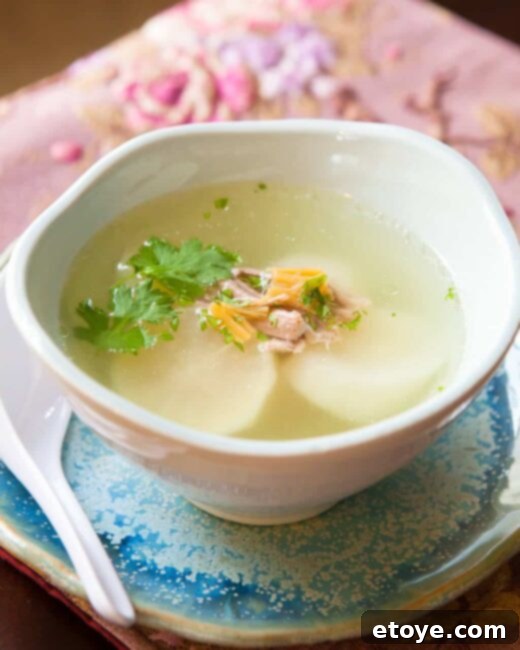Welcome to the comforting world of Chinese soups, where culinary traditions blend with nourishing ingredients to create truly remarkable dishes. While some Chinese soups, like the famous Hot & Sour, are known for their bold, fiery, and deeply satisfying flavors, there’s an equally cherished category dedicated to light, clean, and wonderfully cleansing broths. Today, we delve into one such gem: the Chinese Daikon Soup with Pork. This everyday staple is a testament to the beauty of simplicity, requiring just a handful of ingredients—often as few as three or four—to achieve a profound depth of flavor and numerous health benefits. It’s a remarkably easy and incredibly wholesome addition to any meal, promising a warm, soothing experience with every spoonful.

Why This Daikon Soup Is a Must-Try
This Chinese Daikon Soup isn’t just another recipe; it’s a culinary journey rooted in traditional Asian cooking, celebrated for its ease of preparation and the incredible wellness it brings. Here’s why this humble soup deserves a prominent place in your kitchen:
- Minimal Ingredients, Maximum Flavor: You’ll be amazed at the rich, satisfying taste achieved with just three or four core ingredients. This simplicity makes it a perfect dish for busy weeknights or when you crave something wholesome without extensive shopping.
- Pristine, Clear Broth: The secret to an authentic and visually appealing Daikon soup lies in its crystal-clear broth. We’ll show you how to achieve a pure, unclouded base, free from any impurities, ensuring a delicate and refined taste.
- Umami Boost with Dried Scallops (Optional): For those seeking an extra layer of savory depth, dried scallops are a game-changer. They infuse the broth with a complex umami flavor that elevates the soup to new heights. If not available, we’ll explore equally delicious alternatives.
- Versatile Cooking Methods: Whether you prefer the speed of a pressure cooker, the hands-off convenience of a slow cooker, or the traditional charm of a stovetop simmer, this recipe adapts seamlessly, fitting into any cooking style.
- Nutrient-Rich and Cleansing: Daikon radish is renowned in traditional Asian medicine for its cleansing properties and high vitamin content. Combined with lean pork, this soup is a powerhouse of nutrition, promoting digestion and overall well-being.
- Heartwarming Comfort: Beyond its health benefits, this soup offers unparalleled comfort. Its gentle warmth and subtle flavors make it an ideal dish for soothing colds, chilly evenings, or simply when you need a gentle, restorative meal.
The Essential Ingredients for Your Daikon Soup
Crafting this exquisite soup starts with selecting the freshest and highest-quality ingredients. Here’s what you’ll need:
- Pork (lean cuts are recommended for a cleaner broth)
- Daikon Radish (the star of our soup, choose firm, white roots)
- Dried Scallops (optional, for an intense umami punch)
- Salt (to perfectly season and bring out the natural flavors)
- Fresh Cilantro (optional, for a vibrant garnish and aromatic finish)
While these are the core components, feel free to experiment with additions like carrots for a touch of sweetness and color, or a slice of ginger for an extra layer of warmth.
Step-by-Step Guide: How to Make Chinese Daikon Soup
Creating this delicious and healthy Daikon soup is a straightforward process, regardless of your chosen cooking method. Follow these detailed steps for a perfect result:
- First, it’s crucial to prepare your pork. Par-boil the pork as detailed in the “Clean, Clear Broth” section below. This essential step removes impurities, ensuring your broth is beautifully clear and clean. After par-boiling, rinse the pork thoroughly under cold water to remove any remaining “gunk.”
- In a large cooking pot (suitable for your chosen method), combine the cleaned pork, the peeled and generously chunked daikon, and the dried scallops (if you’re using them for that extra umami depth).
- Add 8-10 cups of fresh water to the pot. The exact amount may vary depending on the size of your pot and how soupy you prefer your finished dish. Ensure all ingredients are well submerged.
- Choose Your Cooking Method:
- Pressure Cooker: Secure the lid and cook under high pressure for 20 minutes. Allow the pressure to release naturally for a richer flavor, or quick-release if you’re in a hurry.
- Slow Cooker: Set to low and cook for a leisurely 8 hours. This method yields incredibly tender pork and a deeply infused broth.
- Stovetop: Bring the pot to a rolling boil over high heat. Once boiling, reduce the heat to low, cover with a lid (leaving a small gap for steam to escape), and simmer gently for at least 2 hours, or longer if you desire more tender pork and a more concentrated broth.
- Once cooked, carefully remove a small amount of broth and taste it. Season the entire pot with salt, starting with 1 teaspoon, then stir and taste again, adjusting to your preference.
- For a final touch, ladle the hot soup into bowls and garnish generously with fresh cilantro, if desired, before serving.

The Secret to a Crystal-Clear Broth in Daikon Soup
Achieving a perfectly clear, clean broth is the hallmark of an exceptional Chinese Daikon Soup. Many home cooks wonder why their meat or bone broths often turn cloudy, sometimes topped with an unappetizing layer of white or grayish foam. This “gunk” is a natural byproduct of cooking raw meat and bones, consisting of coagulated surface proteins, minute bone fragments, residual dirt, and fats. While harmless, these impurities can detract from both the visual appeal and the clean taste of your soup.
The solution lies in a technique called par-boiling, a crucial step that ensures your broth remains pristine. Here’s how to do it effectively:
- Bring a large pot of water to a vigorous boil. The water should be enough to fully submerge your pork.
- Carefully add the raw pork (or bones/meat, if using) to the rapidly boiling water.
- Allow the pork to boil hard for about 5-7 minutes. During this time, you’ll observe a significant amount of foam and impurities rising to the surface. The intense boiling action effectively cleanses the meat, releasing particles and solidifying proteins that would otherwise cloud your final broth.
- Once par-boiled, drain the dirty, cloudy water completely.
- Rinse the par-boiled pork thoroughly under cool running water, making sure to wash away any remaining scum or residue from the surface of the meat.
- Now, your pork is perfectly clean and ready to be used to make a fresh, clear, and delicious broth.
While this extra step might add about 15 minutes to your prep time, the difference it makes in the clarity, purity, and flavor of your Daikon soup is absolutely worth the effort. For those mindful of cholesterol and fat intake, using lean pork cuts or even skinless chicken breast will result in a lighter broth without compromising on taste. We often buy pork roasts on sale, cut them into fist-sized chunks, and freeze them specifically for making nourishing soups like this one.
Mom’s Time-Saving Par-Boiling Shortcut
For those times when you’re short on time but still want a clear broth, my mom has a brilliant shortcut that reduces the par-boiling process to a mere 3 minutes. This method is particularly effective when you’re working with smaller chunks of meat rather than whole bones:
- Bring a quart of water to a boil. You can use an electric kettle or even hot water directly from an instant hot water dispenser if you have one.
- Place the raw pork chunks in a shallow, heat-proof bowl.
- Carefully pour about half of the boiling hot water directly over the pork in the bowl.
- Using tongs or a spoon, gently jiggle each piece of pork in the hot water for about a minute, ensuring all surfaces are exposed to the heat. You’ll immediately see impurities begin to surface.
- Drain and discard the cloudy, murky water from the bowl. This water contains the majority of the unwanted “gunk.”
- Pour the remaining half of the boiling water over the pork again.
- Again, give each piece a gentle jiggle and wiggle in the fresh hot water, and then discard the second batch of cloudy water.
- The final step is to rinse the pork one last time under cool running water from the faucet. Your pork will now be visibly cleaner, lighter in color, and ready to contribute to a perfectly clear broth.
- Dried Chinese or Shiitake Mushrooms: Add 3-4 whole dried mushrooms to your soup. Rehydrate them first for best results. They offer a rich, earthy umami.
- Fresh Chinese or Shiitake Mushrooms: Use 4-5 whole fresh mushrooms. While their flavor is milder than dried, they still contribute a lovely savory note.
- Dried Shrimp: A tablespoon of dried shrimp can provide a concentrated seafood umami reminiscent of scallops. Rinse them before adding.
- Small Chunk of Salt-Cured Ham: A 1-2 ounce piece of a good quality salt-cured ham, like Virginia country ham or Jinhua ham, will infuse your broth with a salty, meaty umami.
- Batch Cooking & Meal Prep: This soup is fantastic for meal prepping! Make a large batch, and it will keep well in the refrigerator for 3-4 days. It also freezes beautifully for longer storage.
- Seasoning is Key: Always taste your soup before the final seasoning. The flavor will concentrate as it cooks, so add salt gradually at the end.
- Pork Selection: For the leanest broth, opt for pork loin or tenderloin. If you prefer a richer soup, cuts with a bit more fat, like pork shoulder or even pork ribs, can be used, but ensure thorough par-boiling.
- Pressure Cooker Release: After cooking in a pressure cooker, you have two options for pressure release: natural release (allowing the pressure to dissipate on its own, which can take 10-20 minutes, leading to more tender meat) or quick release (manually releasing the steam, faster but can make certain meats tougher if not careful). Use a thick kitchen towel and tongs for manual release to protect your hands from steam.
- Serving Suggestions: This soup is wonderful on its own, perhaps with a side of steamed rice. For a more complete meal, serve it alongside other Chinese stir-fries or vegetable dishes.
- Malaysian Chicken Noodle Soup with Asian Greens and Chili-Soy Sauce
- Thai Chicken Coconut Soup (Tom Ka Gai)
- Vietnamese Pho Recipe: Beef Noodle Soup
- Pressure Cooker Ramen Noodle Soup
- 1 pound pork
- 1 large daikon 10 ounces, peeled and cut into large chunks
- 4 dried scallops optional
- salt
- fresh cilantro for garnish optional
- Par boil the pork as shown in photos, then rinse well to clean. In a large pot, add in the pork, daikon and scallops (if using), fill with 8-10 cups of water (depending on capacity of pot.)
- Pressure Cooker: Cook under pressure for 20 minutes
- Slow Cooker: Low 8 hours
- Stovetop: Bring to boil, then reduce heat to low, cover with lid, leaving a little gap for steam to escape and simmer for 2 hours (or more)
- Season with salt – start with 1 teaspoon, stir and taste. Garnish with cilantro, if desired.
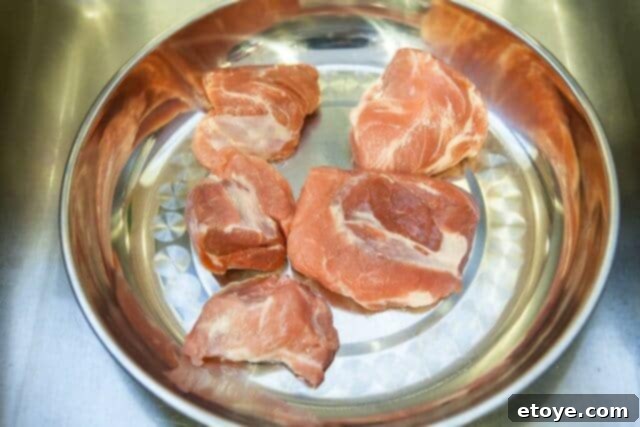
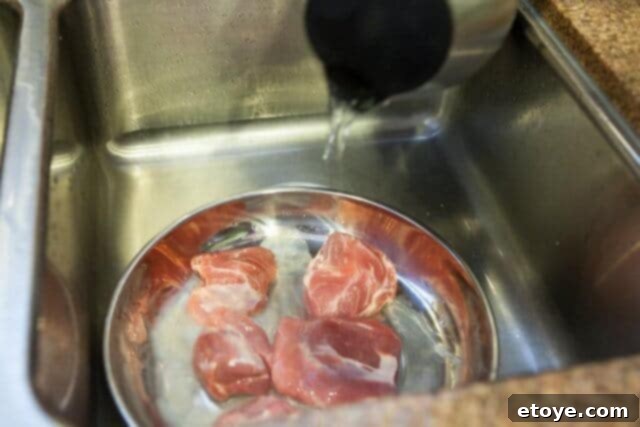
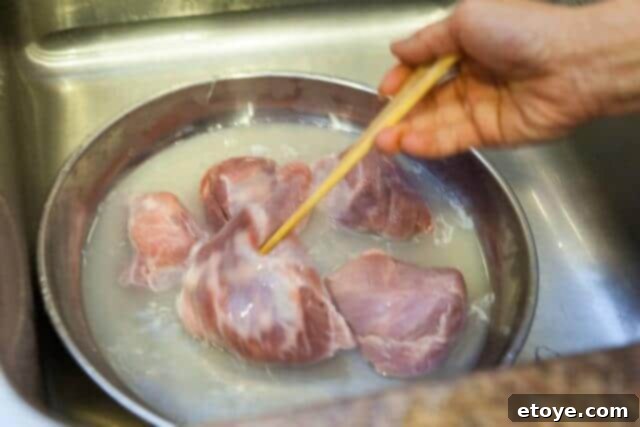
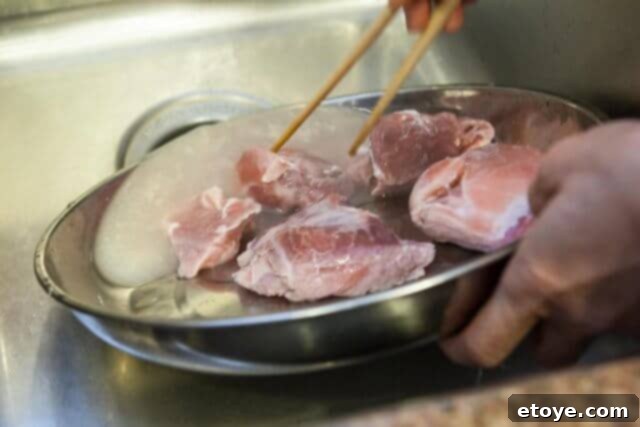
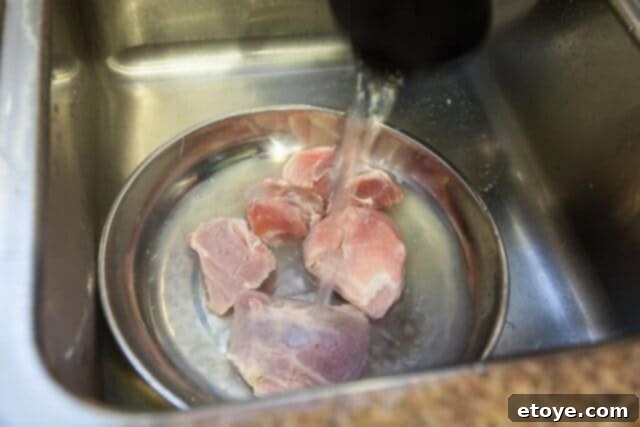
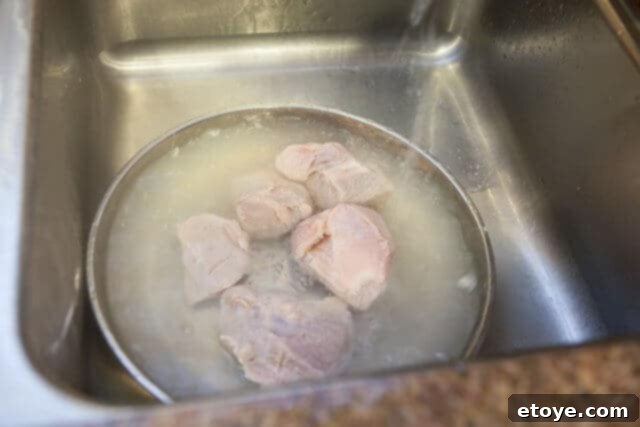
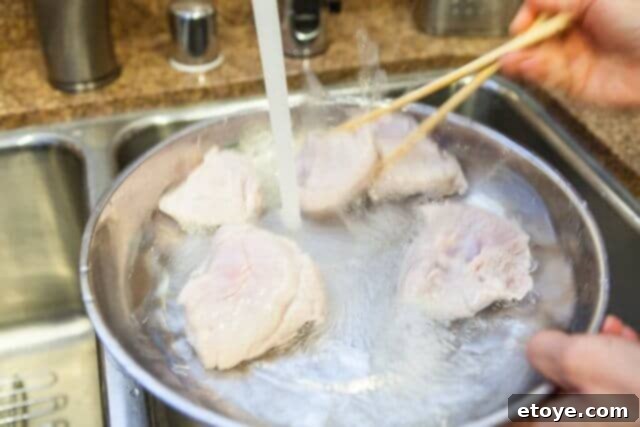
Exploring Daikon: The Star Ingredient
At the heart of our Chinese Daikon Soup is the remarkable daikon radish. This long, white root vegetable is a staple in Asian cuisines and offers a unique flavor profile. When cooked, daikon transforms into a surprisingly mild and sweet ingredient with a delicate, tender texture. However, when grated and eaten raw, it delivers a refreshing crispness with a subtle peppery kick.
Beyond soups, daikon’s versatility shines through in numerous Asian dishes. It’s often pickled to create tangy condiments, stir-fried for a quick side, braised for hours with beef or other meats, or even shredded and incorporated into savory steamed and pan-fried daikon cakes. You’ve likely encountered it raw at Japanese sushi restaurants, where it’s finely shredded and served as a palate cleanser with sashimi, or julienned and pickled alongside carrots in a vibrant Vietnamese salad.
Selecting and Storing Daikon
When selecting daikon, look for roots that are firm, smooth, and uniformly white, without any soft spots or blemishes. The green leaves, if attached, should appear fresh and vibrant. To store daikon effectively, first trim off as much of the green leaves as possible, as they draw moisture from the root. Then, wrap each daikon tightly in plastic wrap to prevent moisture loss and store it in the crisper drawer of your refrigerator. Stored this way, daikon can last for at least one week, often longer.
For this Chinese Daikon Soup recipe, simply peel the daikon with a vegetable peeler, trim and discard the tip and end, and then cut it into generous, bite-sized chunks. These larger pieces will hold their shape well during the long simmering process and absorb all the wonderful flavors of the broth.

Understanding Dried Scallops and Umami
Our Daikon soup receives an incredible boost in flavor when prepared with dried scallops. These small, concentrated morsels are a powerhouse of umami – the fifth basic taste, characterized by a savory, meaty, and deeply satisfying sensation. Dried scallops are a highly prized ingredient in Chinese cuisine, known for imparting a profound seafood sweetness and complexity to broths and braises.
While dried scallops deliver an unparalleled depth, they can be a bit expensive and sometimes challenging to find outside of well-stocked Asian supermarkets. Therefore, they are an optional but highly recommended addition. If you choose not to use them, or if you’re looking for alternative ways to achieve that coveted umami flavor, here are some excellent ingredient substitutions:
Alternatively, if you prefer to keep things simple, feel free to omit these flavor boosters entirely. The combination of pork and daikon still creates a wonderfully flavorful and satisfying soup on its own.
Preparing Dried Scallops
If you’re using dried scallops for your soup, preparation is straightforward. Simply give the scallops a quick rinse under cold water to remove any dust or surface impurities, then add them directly to your pot along with the pork and daikon. They will slowly rehydrate and release their flavors as the soup simmers.
However, if you plan to use dried scallops in a stir-fry or another dish where they need to be tender and easily shredded, you’ll need to soak them first. Place the dried scallops in a bowl and cover them with hot water for about 15-30 minutes, or longer for very large scallops, until they soften. Once rehydrated, you can easily shred them with your fingers or a fork, and the soaking liquid can be added to your dish for extra flavor.

Expert Tips for a Perfect Chinese Daikon Soup

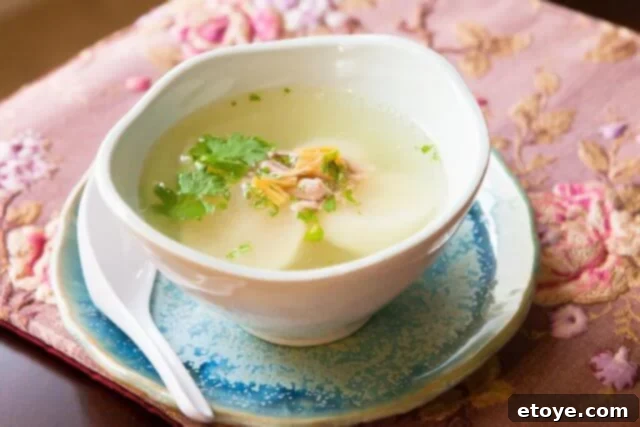
Explore More Delicious Soup Recipes!
If you’ve enjoyed the comforting flavors of this Chinese Daikon Soup, we invite you to explore other heartwarming and authentic Asian soup recipes:
We hope this detailed guide empowers you to create a perfect pot of Chinese Daikon Soup. Have you tried this recipe? We’d love to hear about your experience! Feel free to leave a star rating and share your thoughts in the comments below.
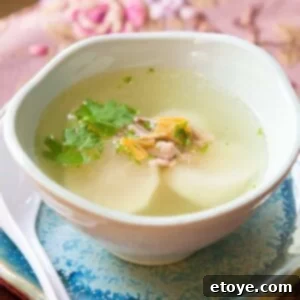
Chinese Daikon Soup Recipe
Jaden Hair
Pin Recipe
Ingredients
Instructions
